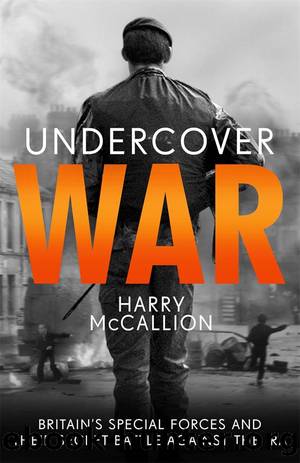Undercover War by Harry McCallion

Author:Harry McCallion
Language: eng
Format: epub
Publisher: John Blake
The IRA
By 1969, the Irish Republican Army was a very different organisation to that which had led the struggle for Irish Independence in the war of 1921. In the nearly half a century that had passed since that defining success, what had once been a mainstream organisation with broad popular support had become a fringe group relegated to the margins of Irish politics. The hardline members of the IRA rejected the treaty that had formed the basis for peace between Britain and Ireland, not only condemning British rule in the north but also rejecting the legitimacy of the Irish state in the south as well. For the true believers of the organisation, the government in the south of the island were sell-outs and it was the IRA Army Council alone that constituted the true and lawful government of the island. For decades, a key part of the identity of the IRA remained the refusal of its members to take part in the official politics of either Britain or the Irish state, a policy that was to lead to frequent splits in the organisation whenever a faction began to take steps down the road to peace.
So committed were the IRA to the long-term fight against the British that, during the Second World War, the organisation’s leaders went so far as to collaborate with the Nazi regime in Germany. In exchange for German support in their struggle, IRA leaders proposed a German invasion of Northern Ireland that would be supported by republican land forces. Unsurprisingly, there were few in either the north or the south of the island who sympathised with such extreme measures.
In the immediate aftermath of the allied victory, with only a few hundred active members remaining and very limited supplies of arms, the IRA had little ability to continue its conflict with Britain. It was not until 1957, after a long period of rebuilding, that it was again in a position to launch a sustained military campaign. The strategy chosen by the IRA’s leadership was to carry out attacks on British military and government infrastructure in border areas, using ‘flying columns’ based in the Republic of Ireland. The goal was to make large areas of the country ungovernable and to demonstrate that British control could not be maintained in the face of armed opposition. The ‘border campaign’, as it became known, was a disaster. Only a handful of British security force members lost their lives over the five years of the campaign, while eight IRA men were killed and hundreds more arrested. Worst of all, the campaign received almost no popular support in Northern Ireland.
With the strategy of direct military confrontation completely discredited for the time being, the leadership of the IRA increasingly fell into the hands of men, such as Cathal Goulding, whose political sympathies lay with the radical left. Throughout the 1960s, a socialist ideology began to replace the old sectarian nationalism that had previously been the core motivating force of the organisation. With it came a
Download
This site does not store any files on its server. We only index and link to content provided by other sites. Please contact the content providers to delete copyright contents if any and email us, we'll remove relevant links or contents immediately.
The Last Days of John Lennon by James Patterson(777)
Bad Law by John Reilly(485)
Do Not Disturb by Michela Wrong(482)
The Cult of We by Eliot Brown & Maureen Farrell(473)
LOGIN TO HELL: A Hacker's Story by HILL ALBERTO DANIEL(455)
Operation Relentless by Damien Lewis(454)
The Profession by Bill Bratton & Peter Knobler(450)
Morgue: A Life in Death by Vincent Dimaio & Ron Franscell(439)
Undercover War by Harry McCallion(437)
For Your Eyes Only by Ben Macintyre(437)
Uncle John's True Crime: A Classic Collection of Crooks, Cops, and Capers by Bathroom Readers' Institute(433)
Ruby Ridge; The Truth and Tragedy of the Randy Weaver Family by Jess Walter(419)
The Big Book of Espionage by Unknown(417)
The Spy Who Came in from the Cold by John le Carre(410)
The Ryan Green True Crime Collection by Green Ryan(405)
The Snow Killings by Marney Rich Keenan(400)
Hollywood Heyday by David Fantle(383)
The Metal Monster by A. Merritt(377)
Notes on a Killing: Love, Lies, and Murder in a Small New Hampshire Town by Kevin Flynn & Rebecca Lavoie(341)
